Eurocom Monster 1.0: Clevo's Little Monster
by Vivek Gowri on May 18, 2012 4:55 AM EST- Posted in
- Laptops
- Clevo
- Eurocom
- Ivy Bridge
- Kepler
Recommendation: Get the Upgraded Matte Display
The standard display is a glossy 11.6” WXGA panel made by Infovision Optoelectronics. And it is…terrible. The maximum brightness of 258 nits isn’t bad, but the 177:1 contrast ratio is appalling. Actually from a numbers standpoint, it matches up pretty well with the M11x R3 display. The less said, the better.
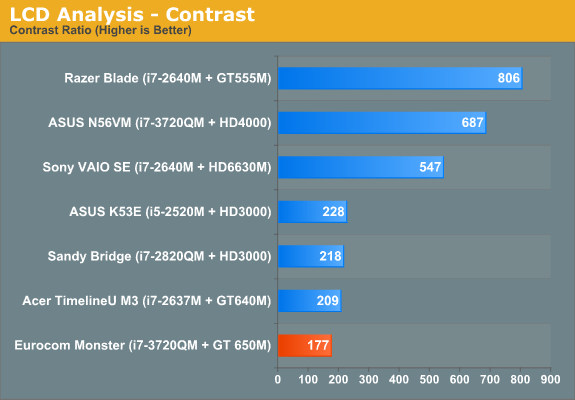
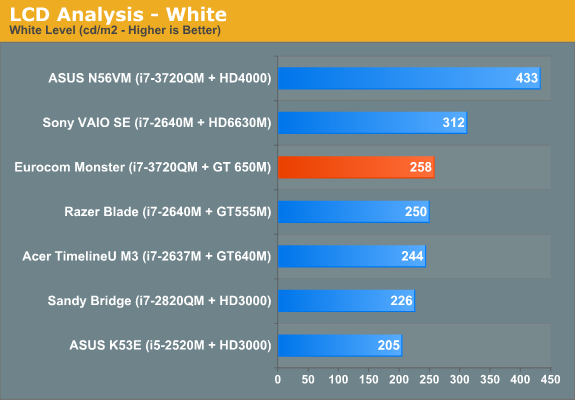
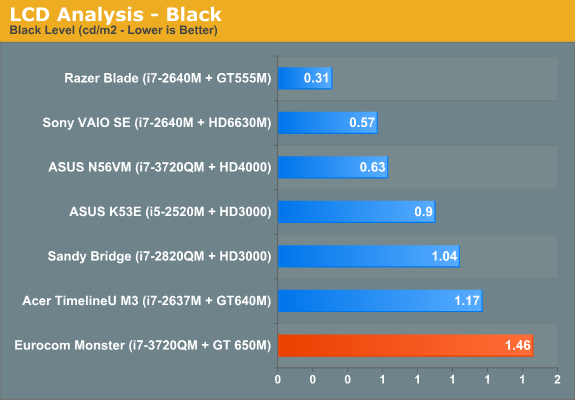
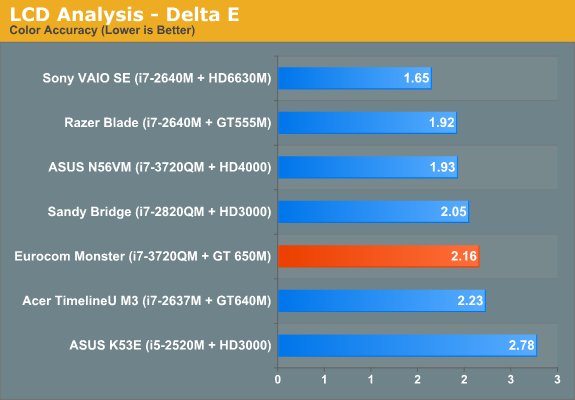
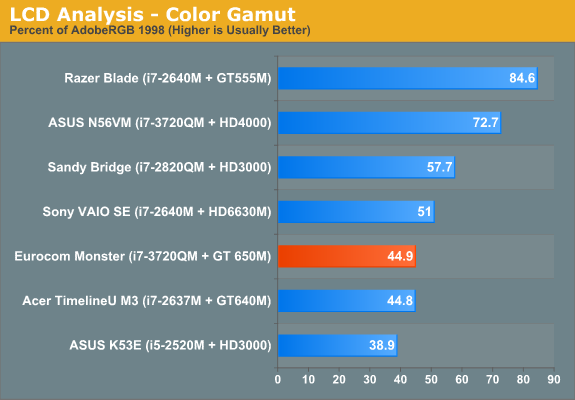
Happily, Eurocom offers another option—a matte AUO B116XW02. It’s rated to have a 500:1 contrast ratio and a max luminance of 200 nits, and the matte finish is always welcome. Interestingly, the part cost at various internet retailers is in the $60 range, but Eurocom charges $150 for the upgrade. Unfortunately, it wasn’t available to review at the time Eurocom shipped our evaluation unit, so I can’t verify the claims made in the data sheet, but it’s doubtless a major upgrade from the stock IVO display.
We haven’t seen too many impressive 11.6” displays, other than the one in the 11.6” MacBook Air. The MBA 11” has three different suppliers for screen—LG Phillips, Samsung, and AU Optronics. The AUO screen part number is B116XW05, and we measured one with a 575:1 contrast ratio back in 2010 (our 2011 review units had LG Phillips and Samsung panels—just part of the lottery). Food for thought.










47 Comments
View All Comments
fic2 - Friday, May 18, 2012 - link
Cue the lawsuit from Monster Cable in 3, 2, 1...hsew - Friday, May 18, 2012 - link
This needs an mSata port and a higher resolution display option and it would be worth buying. Thunderbolt would be nice but not critically necessary. Guess that's why they called it the 1.0.Beenthere - Friday, May 18, 2012 - link
...and a 45w CPU for a 11.6" laptop sure don't make good sense.RoninX - Friday, May 18, 2012 - link
It would be interesting to see a comparison, in terms of design and hardware options, of all the different OEM varieties of this Clevo (Eurocom, Origin, Maingear, etc.). Of course, the performance will be similar, if not identical, but the look and feel, and the choices in terms of screens and SSDs, may be different...Also, is there any way to get a 9-cell battery for this?
slim142 - Friday, May 18, 2012 - link
This laptop in 14" with Matte screen, 1680x1050 (or, if too much, then 1440x900) resolution. I would jump on it immediately.maniac5999 - Friday, May 18, 2012 - link
Actually, I have a 12" laptop (MSi Wind 230) and I think that 768p is the right resolution for this size.yhselp - Saturday, May 19, 2012 - link
It really boggles my mind when competent people, even professionals, make subjective claims about products. Did they get caught up in marketing to such an extent that they're no longer able to see a product for what it really is? When was the m11x anything but a shameless, uninnovative shirking of an already dated chassis? A thick notebook which weighs as much as a regular 13.3-incher, yet has a tiny screen and unimpressive components. I'm not saying it's a bad product per se, just an unimaginative one that doesn't push the envelope in any way. Not to mention a glossy screen on an 'ultraportable' machine, although that's a problem with so many products nowadays.What I'm trying to say here, as someone who knows a little about thermal design, is that very few notebooks on the market make optimal use of TDP, and as a result the public has an unrealistic opinion of what's possible. Many people would be surprised by what components you can actually stuff in a given chassis. I don't feel competent enough to say why that is, but I suspect it has something to do with companies being reluctant to develop (and well) new designs as often as they should - even Apple.
W110ER is not a thermal miracle, it doesn't break the laws of physics - it just makes adequate use of thermal limits. However, it's fair to say that the inclusion of 45W CPUs is quite bold (not in a bad way). As for the product itself - it's pretty good (apart from the generic outer design), although I feel that it lacks focus. I'd much rather have either a truly portable 11.6-incher that weighs under 3 lbs and packs a ULV + 640m, or a more practical (and still portable) 13.3-incher at 4.5 lbs with a 35W quad-core + 660m.
I really like it how you guys at AnandTech constantly preach about better displays. In your Vaio SE review you said that its IPS panel should be the bare minimum nowadays - I agree. And to that I'd also add proper thermal optimization. Perhaps Haswell will bring that.
I hope I haven't been offensive, that was not my intent.
VivekGowri - Sunday, May 20, 2012 - link
Set a 4.5lb weight limit, and how many decent gaming systems have there been over the last 3 years? The M11x, the VAIO SA, the first two generations of VAIO Z series (not the new Power Media Dock one), and how many others? The M11x was really the only one of those to be focused on gaming, and the GT 335M was pretty sweet at the $799 price point (in 2010). I wasn't really a huge fan of the M11x (in any of its 3 iterations, actually) primarily due to the size/weight vs screen size, but it was relatively unique in pushing the concept of portable gaming, and that's all the opening paragraph was trying to say.ijozic - Monday, May 21, 2012 - link
Well, there is the 13,3" LG P330 which has a much better design and materials (IMHO), though it's dual core + 555M (somewhat slower than the 650M). Unfortunately, it has a glossy screen, no backlighted keyboard and it's only available in Korea. Hopefully, they'll make an IB refresh and release it worldwide.yhselp - Tuesday, May 22, 2012 - link
Yes, the LG P-series are (and have been) generally well optimized portables. Unfortunately, they've also never been widely available in the US or anywhere outside Korea for that matter. I wonder whether anyone remembers the excellent LG P300 - it used to be a direct competitor to the famous Dell M1330. Unlike the Dell, however, it had a 8600M GS (compared to the slower 8400 GS), better battery life and a somewhat sturdier design. It was quite the machine back then.